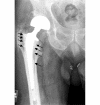The role played by cell-substrate interactions in the pathogenesis of osteoclast-mediated peri-implant osteolysis
- PMID: 16613614
- PMCID: PMC1526628
- DOI: 10.1186/ar1938
The role played by cell-substrate interactions in the pathogenesis of osteoclast-mediated peri-implant osteolysis
Abstract
Prosthetic wear debris-induced peri-implant osteolysis is a major cause of aseptic loosening after total joint replacement. In this condition, wear particles released from the implant components induce a granulomatous inflammatory reaction at the interface between implant and adjacent bone, leading to progressive bone resorption and loss of fixation. The present study was undertaken to characterize definitively the phenotype of osteoclast-like cells associated with regions of peri-implant focal bone resorption and to compare the phenotypic features of these cells with those of mononucleated and multinucleated cells associated with polyethylene wear particles. Peri-implant tissues were obtained from patients undergoing hip revision surgery for aseptic loosening after total joint replacement. Cells were examined for the expression of several markers associated with the osteoclast phenotype using immunohistochemistry, histochemistry, and/or in situ hybridization. CD68 protein, a marker expressed by multiple macrophage lineage cell types, was detected in mononucleated and multinucleated cells associated with polyethylene particles and the bone surface. Cathepsin K and tartrate-resistant acid phosphatase were expressed highly in both mononucleated and multinucleated cells associated with the bone surface. Levels of expression were much lower in cells associated with polyethylene particles. High levels of beta3 integrin protein were detected in cells in contact with bone. Multinucleated cells associated with polyethylene particles exhibited faint positive staining. Calcitonin receptor mRNA expression was detected solely in multinucleated cells present in resorption lacunae on the bone surface and was absent in cells associated with polyethylene particles. Our findings provide further evidence that cells expressing the full repertoire of osteoclast phenotypic markers are involved in the pathogenesis of peri-implant osteolysis after total joint replacement. They also demonstrate that foreign body giant cells, although believed to be phenotypically and functionally distinct from osteoclasts, express many osteoclast-associated genes and gene products. However, the levels and patterns of expression of these genes in the two cell types differ. We speculate that, in addition to the role of cytokines and growth factors, the substrate with which these cells interact plays a critical role in their differential phenotypic and functional properties.
Figures







References
-
- Shinar DM, Schmidt A, Halperin D, Rodan GA, Weinreb M. Expression of alpha v and beta 3 integrin subunits in rat osteoclasts in situ. J Bone Miner Res. 1993;8:403–414. - PubMed
-
- Nesbitt S, Nesbit A, Helfrich M, Horton M. Biochemical characterization of human osteoclast integrins. Osteoclasts express alpha v beta 3, alpha 2 beta 1, and alpha v beta 1 integrins. J Biol Chem. 1993;268:16737–16745. - PubMed
Publication types
MeSH terms
Substances
Grants and funding
LinkOut - more resources
Full Text Sources
Other Literature Sources

